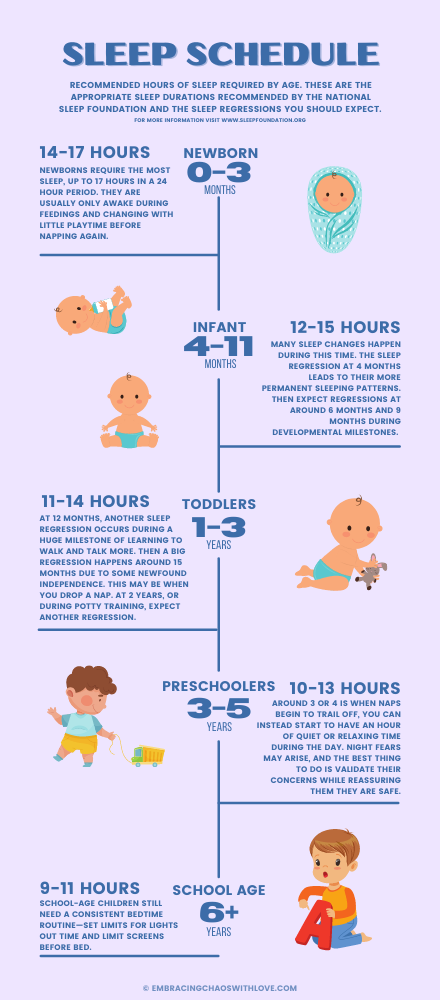12-month sleep regression can happen to even the best sleeper. Whenever a baby’s sleep routine goes through a rough patch or takes a step back from their normal healthy sleep habits, it is a sleep regression.
If your newly 1-year-old or soon-to-be 1-year-old is suddenly having a hard time falling or staying asleep or is suddenly up more than usual throughout nighttime sleep, your baby may be going through the 12 months sleep regression.
What are the symptoms and signs of a 12 month sleep regression?
Some symptoms and signs that your child is going through a 12 month sleep regression:
- Taking longer to fall asleep or settle down.
- More frequent nighttime wake-ups
- Overall Fussiness
- Longer naps
Causes of the 12 months sleep regression?
- Changes in their development- they have greater emotional engagement, increased communication, heightened cognitive skills and expanded physical abilities.
- Overstimulation related to increased physical growth and activity levels
- Separation
- Teething
- Night terrors
How long is the 12 month sleep regression?
You may feel like you just got done with a sleep regression, which may be true. Sleep regressions occur around 4 months, 6 months, 9 months, and now at 12 months.
This sleep regression can actually start in the 10th month, depending on when your baby starts walking. Most sleep regressions come at the same time as developmental milestones.
Around 10-12 months, your baby learns to take those first steps and maybe start to talk. They are also going through growth spurts that can contribute to sleep regression.
How do you deal with sleep regression at 12 months?
At 12 months, your baby may be talking more and maneuvering its body in new ways. They may want to continue practicing their discoveries well into the night, causing sleep problems and making it difficult for them to get to sleep and then stay asleep in their crib.
The best way to deal with a sleep regression is to go about your normal routine and bedtime schedule as much as possible. Try not to start anything new during these sleep regressions, as that can make them last longer.

Be patient with your child and know that this phase will soon pass and their sleep patterns will soon go back to normal. You may be thinking you should drop a nap during the day to get them to sleep more at night, but that can make the regression longer. Babies are typically not ready to drop that second nap until 15-18 months.
What to do during the 12-month sleep regression?
- Keep them active during wake times.
- Give them more attention throughout the day.
- Add a nightlight
- Have Patience
- Keep a Routine
- Give them a lovey or stuffed animal for naps and nighttime.
- Eliminate any stimulation close to bedtime and throughout the night
- Have a good bedtime routine.
FAQ’s of the 12-month sleep regression
Is there a sleep regression at 12 months?
When there is a big step forward in their developmental milestones, it is usually followed by a step back in the sleep department. Meaning, with the exciting new things your baby is learning and doing around their first birthday, there is also a sleep regression.
The 12-month sleep regression can last anywhere from 3-6 weeks, depending on how many different milestones they are going through when it starts.
Why is my 1-year old waking up screaming?
Not only are they going through physical and emotional changes in their life, but they now are understanding the idea of separation. This can lead to separation anxiety. When they wake and find they are alone, especially if you comforted them to sleep, they might get scared upon waking.
Night terrors may also be occurring from being overstimulated during the day. When your child is learning new skills and going through a milestone, this could cause them to be overstimulated.
How does a child’s sleep change around 12 months?
Around 12 months, your child goes from needing around 12-15 hours of sleep in a 24 hour period to needing 11-14 hours. They may start taking longer naps during the day but waking more at night during this regression. Be patient, this doesn’t mean all of your sleep training was wasted.

When to call a doctor?
Sleep regressions are normal and as long as your child is showing the following signs there should be no reason to worry:
- Growing and gaining weight steadily.
- Feeding well 8 to 12 times a day for a breastfeeding baby or 5 to 8 times a day for a bottle-fed baby or older infant.
- Urinating normally with at least 4 wet diapers a day.
- Having at least 3 normal bowel movements per day. Most breastfeeding babies have more frequent bowel movements that are soft and seedy.
It is something you can bring up at their next well check appointment and your doctor may bring it up too.
Signs to look out for and when you should contact your doctor immediately:
- Lack of growth or weight gain
- Abnormal breathing or snoring at night
- Changes to their eating habits (i.e., not eating)
- Changes to their eliminating habits
- Significant nighttime fears
Note: This is not medical advice but opinions only. Contact your doctor whenever you have any concerns about your child’s wellbeing.
Recommended Sleep Schedule for a 12-month-old
According to the National Sleep Foundation, toddlers’ appropriate sleep duration is between 11 and 14 hours. It is also recommended that toddlers continue to take 2 naps during the day until 15-18 months.
It is important during a sleep regression that you stick to any routines or schedules you previously had. Don’t try changing too much in your daily or nightly routine, as that could make the regression longer.
During any wake-ups at night, please don’t provide any stimulation while comforting them back to sleep. Try to dream feed if you are still nursing. Don’t turn on the lights or make a lot of noise.
Try practicing separation during the day so that nighttime isn’t the only time they are separated from you. This could ease the separation anxiety they may feel at night time.
Giving your baby lots of attention and comfort during the day can help them feel safe and secure. Rest assured, giving your baby lots of comforts will not make this behavior continue but makes them feel secure to regulate their emotions easier.
Pay attention to any signs that your child may be getting tired or overstimulated.

- If they are tired, they may be getting fussy, rubbing their eyes, yawning, and acting bored with toys.
- If your child is overstimulated, they will cover their face with their hands, have jerky movements, cry with a more high-pitched sound, and may become very withdrawn or hyperactive (depending on your child’s normal demeanor).
Conclusion
All babies go through sleep regressions throughout their first year. Before sleep regressions, your child may appear to sleep through the night by soothing themselves back to sleep, or they may need extra help throughout the night to get back to sleep. Both of these examples are good sleepers.
Being a good sleeper does not mean that they do not wake throughout the night. According to the American Academy of Pediatrics, it is actually considered unhealthy to sleep prolonged periods of time undisturbed.
So, What Is Considered A Good Sleeper?
It is very normal for babies and toddlers to wake frequently during the night. It is developmentally appropriate for them because it allows them to wake if anything is wrong (they have to pee, not getting enough oxygen, breathing problems, etc.). During sleep regressions, we may notice them waking more because they have difficulties self-soothing and need some help getting back to sleep.
It is important for parents and all caregivers to understand that a good sleeper frequently wakes during the night but can get back to sleep. A good sleeper does not indicate that they stay asleep for long stretches without waking.
Once the sleep regression is over, they will usually go back to self-soothing throughout the night. Have patience for your baby when they need a little extra help getting back to sleep at night.



